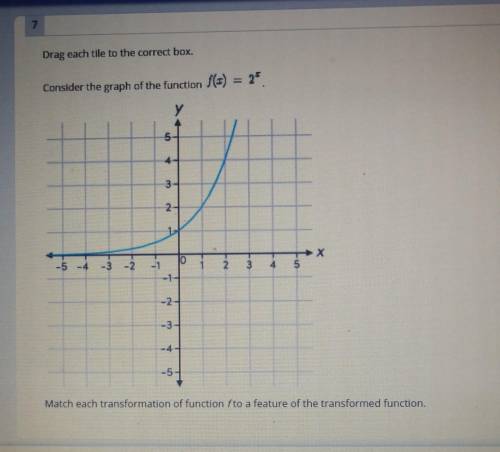
Mathematics, 13.10.2020 01:01 zahid79
Match each transformation of function f to a feature of the transformed function.
Transformations of function f:
j(x)= f(x+2)
m(x)= -f(x)
g(x)= 2f(x)
h(x)= f(x)+2
Features that must be matched to the transformations:
asymptote of y=2
function decreases as X increases
y intercept at 0,4
y intercept at 0,2
I have to have this answer! Please help. There will be a massive reward.


Answers: 3


Another question on Mathematics

Mathematics, 21.06.2019 16:00
Determine the volume of a cylinder bucket if the diameter is 8.5 in. and the height is 11.5 in.
Answers: 1

Mathematics, 21.06.2019 21:00
Estimate the area under the curve f(x) = 16 - x^2 from x = 0 to x = 3 by using three inscribed (under the curve) rectangles. answer to the nearest integer.
Answers: 1

Mathematics, 21.06.2019 21:00
Ariana starts with 100 milligrams of a radioactive substance. the amount of the substance decreases by 20% each week for a number of weeks, w. the expression 100(1−0.2)w finds the amount of radioactive substance remaining after w weeks. which statement about this expression is true? a) it is the difference between the initial amount and the percent decrease. b) it is the difference between the initial amount and the decay factor after w weeks. c) it is the initial amount raised to the decay factor after w weeks. d) it is the product of the initial amount and the decay factor after w weeks.
Answers: 1

Mathematics, 21.06.2019 23:00
The equation shown below represents function f. f(x)= -2x+5 the graph shown below represents function g. which of the following statements is true? a. over the interval [2, 4], the average rate of change of f is the same as the average rate of change of g. the y-intercept of function f is less than the y-intercept of function g. b. over the interval [2, 4], the average rate of change of f is greater than the average rate of change of g. the y-intercept of function f is greater than the y-intercept of function g. c. over the interval [2, 4], the average rate of change of f is the same as the average rate of change of g. the y-intercept of function f is greater than the y-intercept of function g. d. over the interval [2, 4], the average rate of change of f is less than the average rate of change of g. the y-intercept of function f is the same as the y-intercept of function g.
Answers: 1
You know the right answer?
Match each transformation of function f to a feature of the transformed function.
Transformations o...
Questions




Mathematics, 26.11.2020 04:10

English, 26.11.2020 04:10

Mathematics, 26.11.2020 04:10

History, 26.11.2020 04:10








Physics, 26.11.2020 04:10


Mathematics, 26.11.2020 04:10


English, 26.11.2020 04:10



